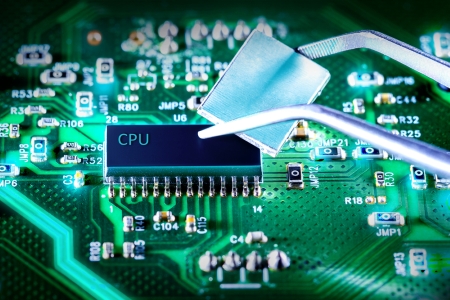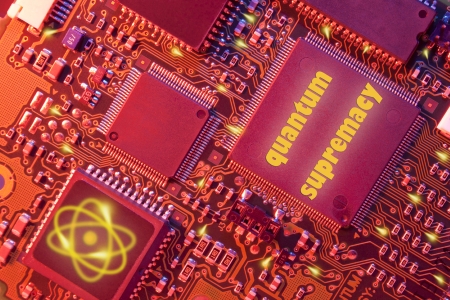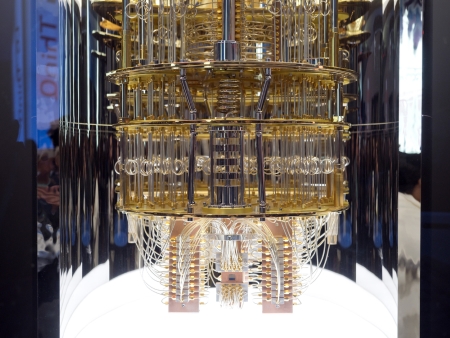Quantum computing might not be a household word. However, it could also change civilization as we know it. We at ER Optics chose this topic because of a recent discovery, and the fact that silicon is at the heart of the breakthrough.
The discovery could allow us to build scalable quantum computers. Likewise, this recent insight could connect those super-fast quantum computers to each other on a quantum internet. Additionally, all of this will empower enormous “advances in many fields. Those fields include chemistry, materials science, medicine, and cybersecurity.”
A Quick Glimpse at Quantum Computing: Unlocked with Silicon

Working at the Atomic Level: Qubits Carry Information in a Molecular Way Faster Than Today’s Most Sophisticated Super Computers.
To understand the amazing quality of the new scientific information, we bring you a quick look at a few terms. Don’t worry, you will not have to take a deep dive into Quantum technology to get an understanding of the new breakthrough.
However, let us pause and tease you with that mystery for a few moments. Meanwhile, we will share three background facts that might help you better appreciate the new discovery.
Three Quick Quantum Computing Facts Revealed
What is Quantum Computing? By definition, quantum computing “involves the sharing of information at atomic and subatomic levels through quantum channels.”
Moreover, experts tell us “Compared to classical computing, quantum computing can share information at infinitely higher rates…”
An added phenomenon is that quantum computing is “a great deal more secure than classical computing.” You can find out more about quantum computing at the informative online link above.
The Qubit: Measurements and Communication
We will soon be telling you about the silicon connection in quantum computing. However, first, get acquainted with the term “Qubit.”
We all refer to classic computer information in “bits.” However, in quantum computing, pieces of information shared between high-powered quantum computers are designated as “qubits” A qubit “serves a similar purpose in quantum computing to a binary character in traditional computing.”
How Do You Solve the Problem with a Qubit?

Quantum Processing Chip Creation Will Yield Faster System Analysis. Resulting examples include: Quicker Medical Discoveries, Unsnarl the Supply Chain, and Revolutionize Industry.
Experts have long described the fact that standard hardware could not interpret a qubit. As a result, Classic and quantum computers could not communicate. Therefore, we did not think they could until a recent, amazing discovery.
Firstly, researchers at Simon Frazer University “made a crucial breakthrough in the development of quantum technology.” Research Scientists Daniel Higginbottom, Alex Kurkjian, and co-authors have offered “proof of principle that T centers, a specific luminescent defect in silicon…” Additionally, they can “provide a ‘photonic link’ between qubits.”
We warned you that silicon would be the key to unlocking this problem. You see, the new discovery was born at the “SFU Silicon Quantum Technology Lab in SFU’s Physics Department…” Stephanie Simmons, Canada Research Chair in Silicon Quantum Technologies, and Michael Thewalt, Professor Emeritus, co-led the research.
Clarifying a Quantum Computing Complex Discovery
The scientists examined over “150,000 silicon ‘T center’ photon-spin qubits.” They wanted to prove that silicon could do two simultaneous tasks:
1. Firstly, they needed to “Produce both stable, long-lived qubits that provide processing power…”
2. Secondly, they wanted the qubits to carry “the communications technology that enables these qubits to link together at scale.”
(By the way, “at scale” would mean we could mass produce quantum computers. Moreover, they would be offered at reasonable prices. By reasonable prices, we mean research institutions in multiple scientific fields could actually use them.)
Linking together, the qubits of information could be communicated on a silicon Internet. (For more information on quantum computing, check out this reliable online resource.

Quantum Supremacy Will Cause the Next Industrial Revolution. We’re Working On It.
New Discovery Stands on the Shoulders of Past Research
Keep in mind that these scientists already knew, “that silicon can produce some of the most stable and long-lived qubits in the industry…”
Thus, the researchers realized, that “An emitter like the T center” does two important things:
1. It takes high-performance spin qubits…
2. Additionally, it combines them with optical photo generation. Therefore, the silicon T center, hitherto considered a luminescent defect, could empower scalable quantum computers.
3. Why? “They can manage “the processing and the communications together, rather than needing to interface two different quantum technologies…” said Dr. Simmons. And to emphasis this point, she repeated they would not need separate technologies, “one for processing and one for communications…”
A Closer Look at T Centers of Silicon
You see, the T centers “have the advantage of emitting light at the same wavelength that today’s metropolitan fiber communications and telecom networking equipment use.”
Thus, Simmons explained, “With T centers, you can build quantum processors that inherently communicate with other processors.” This was a huge insight.
She continued, “…Your silicon qubit can communicate by emitting photons (light) in the same band used in data centers and fiber networks…” She added, Then, “you get these same benefits for connecting the millions of qubits needed for quantum computing.”
Building the Future of New Technology
Now, we have Terrific Take-Aways on “Developing quantum technology using “silicon.” It makes sense. Silicon will pave the way for rapidly scaling quantum computing.
Meanwhile, we can observe that “The global semiconductor industry is already able to inexpensively manufacture silicon computer chips at scale, with a staggering degree of precision.” Currently, the limiting factor is the semi-conductor shortage we discussed in our previous blog.
Terrific Take-Aways from Silicon Technology

Quantum Computers Do Not Look or Act Like Classic Computers. Moreover, They Are Much Faster.
That chip technology creates the heart of traditional computing. It empowers function in everything from your smartphone to the most powerful supercomputers on earth. For additional detailed information, visit this site.
Simmons summarized it best as she stated, “By finding a way to create quantum computing processors in silicon, you can take advantage of all of the years of development, knowledge, and infrastructure used to manufacture conventional computers…”
This certainly makes more sense than building a whole new industry for quantum manufacturing,” Simmons says. And she added, “This represents an almost insurmountable competitive advantage in the international race for a quantum computer.”
At Simon Fraser University, researchers call this discovery “…the missing photonic link to enable an all-silicon quantum internet.”
We think it is fascinating that the T center, long regarded as a specific luminescent defect in silicon, will become the hero of this discovery. The T center’s power to “provide a ‘photonic link’ between qubits” is no longer a defect, but a gift.
ER Precision Optics believes we might need a few more such insightful discoveries before we can build scalable quantum computing and the silicon quantum internet. One thing, we do feel is certain: the future is built of silicon.


